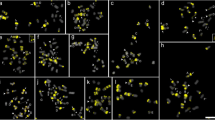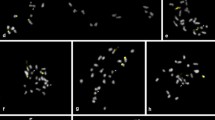Abstract
Meiosis in seven interspecificCucumis hybrids has been analysed i.a. inC. metuliferus ×C. zeyheri, where the parents belong to different sections. In the triploid hybrids a remarkably high number of trivalents has been found. Additional data from literature on geographical distribution, cucurbitacins, flavonoid patterns, isozymes, C-banding, genome size, DNA amount and chloroplast DNA are used to discuss species relationships and evolution. The African cross-compatible group is divided into theMyriocarpus subgroup with the diploid speciesC. africanus, C. myriocarpus subsp.leptodermis and subsp.myriocarpus, and theAnguria subgroup withC. anguria, C. dipsaceus, C. ficifolius, C. prophetarum, C. zeyheri and all polyploids (exceptC. heptadactylus). It is argued that the Asian subg.Melo with x = 7 is derived from the African subg.Cucumis with x = 12; the latter contains all the polyploid species and has the most common basic chromosome number of theCucurbitaceae. This phylogenetic advance is interpreted with concepts of the quantum model of evolution.
Similar content being viewed by others
References
Ayyanger, K. R., 1967: Taxonomy ofCucurbitaceae. — Bull. Nat. Inst. Sci. India34: 380–396.
Batra, S., 1953: Interspecific hybridization in the genusCucumis. — Sci. Cult.18: 445–446.
Berg, R. G. van den, 1985: Pollen morphology of the genusBegonia in Africa. — Diss. Agricultural Univ., Wageningen.
Bhaduri, P. N., Bose, P. C., 1948: Cytogenetic investigations in some Cucurbits with special reference to fragmentation of chromosomes as a physical basis of speciation. — J. Genet.48: 237–256.
Brown, G. B., Deakin, J. R., Wood, M. B., 1969: Identification ofCucumis species by paper chromatography of flavonoids. — J. Amer. Soc. Hort. Sci.94: 231–234.
Dane, F., 1976: Evolutionary studies in the genusCucumis. — Ph.D. Diss., C.S.U., Fort Collins, Colorado.
—, 1983: Cucurbits. — InTanksley, S. D., Orton, T. J., (Eds.): Isozymes in plant genetics and breeding, pp. 369–390. — Amsterdam: Elsevier.
—,Tsuchiya, T., 1979: Meiotic chromosome and pollen morphological studies of polyploidCucumis species. — Euphytica28: 563–567.
—,Denna, D. W., Tsuchiya, T., 1980: Evolutionary studies of wild species in the genusCucumis. — Z. Pflanzenzüchtung.85: 89–109.
Deakin, J. R., Bohn, G. W., Whitaker, T. W., 1971: Interspecific hybridization inCucumis. — Econ. Bot.25: 195–211.
Ehrendorfer, F., Schweizer, D., Greger, H., Humphries, C., 1977: Chromosome banding and synthetic systematics inAnacyclus (Asteraceae-Anthemidae). — Taxon26: 387–394.
Enslin, P. R., Rehm, S., 1958: The distribution and biogenesis of the cucurbitacins in relation to the taxonomy of theCucurbitaceae. — Proc. Linn. Soc. London169: 230–238.
Esquinas-Alcazar, J. T., 1977: Alloenzyme variation and relationships in the genusCucumis. — Ph.D. Diss., University of California, Davis, California.
Grant, V., 1980: Plant speciation, 2nd edn. — New York, London: Columbia Univ. Press.
Greilhuber, J., Deumling, B., Speta, F., 1981: Evolutionary aspects of chromosome banding, heterochromatin, satellite DNA and genome size inScilla (Liliaceae). — Ber. Deutsch. Bot. Ges.94: 249–266.
Hoen, P., 1985: Pollen morphology of the tribeDorsteniae (Moraceae), excluding the generaBrosimium, Helianthostylis andTrymathocoecus. — Stuifmail3: 5–7, Palaeobot. Palynol. Soc. Utrecht.
Jeffrey, C., 1967: Flora of Tropical East Africa,Cucurbitaceae. — London: Crown agents for overseas governments and administrations.
—, 1980: A review of theCucurbitaceae. — Bot. J. Linn. Soc.81: 233–247.
Kho, Y. O., den Nijs, A. P. M., Franken, J., 1980: Interspecific hybridization inCucumis L. 2. The crossability of species, an investigation of in vivo pollen tube growth. — Euphytica29: 661–672.
Kishi, Y., Fujishita, N., 1969: Studies on interspecific hybridization in the genusCucumis 1. Pollen germination and pollen tube growth in selfings and incompatible crossings. — J. Japan Soc. Hort. Sci.38: 329–334.
—, —, 1970: Studies on the interspecific hybridization in the genusCucumis 2. Pollen tube growth, fertilization and embryogenesis of post-fertilization stage in incompatible crossings. — J. Japan Soc. Hort. Sci.39: 149–156.
Ladizinsky, G., 1985: Founder effect in crop-plant evolution. — Econ. Bot.39: 191–199.
Loidl, J., 1983: Some features of heterochromatin in wildAllium species. — Pl. Syst. Evol.143: 117–131.
Mallick, M. F. R., Masui, M., 1986: Origin, distribution and taxonomy of melons. — Sci. Hort.28: 251–261.
Meeuse, A. D. J., 1965: TheCucurbitaceae of Southern Africa. — Bothalia8: 59–82.
—, 1985: The possible origin ofCucumis anguria L. — Blumea Suppl.4: 196–204.
Naudin, C. V., 1859: Revue des Cucurbitacees. — Ann. Sci. Nat. Bot., Ser. 4,12: 79–128; 129–164.
Nijs, A. P. M. den, Visser, D. L., 1985: Relationship between African species of the genusCucumis L. estimated by the production, vigour and fertility of F 1 hybrids. — Euphytica34: 279–290.
Perl-Treves, R., Galun, E., 1985: TheCucumis plastome: physical map, intrageneric variation and phylogenetic relationships. — Theor. Appl. Gen.71: 417–429.
—,Zamir, D., Navot, N., Galun, E., 1985: Phylogeny ofCucumis based on isozyme variability and its comparison with plastome phylogeny. — Theor. Appl. Gen.71: 430–436.
Quiros, C. F., 1983: Alfalfa. — InTanksley, S. D., Orton, T. J., (Eds.): Isozymes in plant genetics and breeding, pp. 253–294. — Amsterdam: Elsevier.
Raamsdonk, L. W. D. van, 1985a: Pollenfertility and seed formation in theOrnithogalum umbellatum/angustifolium complex (Liliaceae/Scilloideae). — Pl. Syst. Evol.149: 287–297.
—, 1985b: Crossing and selfing experiments in theOrnithogalum umbellatum/angustifolium complex. — Pl. Syst. Evol150: 179–190.
-Visser, D. L., 1989: Autotetraploidy inCucumis zeyheri and a related new speciesC. ×dinii derived from it. — Pl. Syst. Evol. (submitted).
Ramachandran, C., Narayan, R. K. J., 1985: Evolution of chromosomal DNA inCucumis. — Theor. Appl. Gen.69: 497–502.
—,Seshadri, V. S., 1986: Cytological analysis of the genome of Cucumber (Cucumis sativis L.) and Muskmelon (Cucumis melo L.). — Z. Pflanzenzüchtung96: 25–38.
—,Brandenburg, W. A., den Nijs, A. P. M., 1985: Infraspecific variation in C-banded karyotype and chiasma frequency inCucumis sativus (Cucurbitaceae). — Pl. Syst. Evol.151:31–41.
Rick, C. M., 1983: Tomato. — InTanksley, S. D., Orton, T. J., (Eds.): Isozymes in plant genetics and breeding, pp. 147–166. — Amsterdam: Elsevier.
Singh, A. K., Roy, R. P., 1974: Karyological studies inCucumis L. — Caryologia27: 153–160.
—,Yadava, K. S., 1984: An analysis of interspecific hybrids and phylogenetic implications inCucumis (Cucurbitaceae). — Pl. Syst. Evol.147: 237–252.
Smith, J. S. C., Goodman, M. M., Stuber, C., 1985: Relationship between Maize and Teosinthe of Mexico and Guatemala: numerical analysis of allozyme data. — Econ. Bot.39: 12–24.
Staub, J. E., Fredrick, L., Marty, T., 1987: Electrophoretic variation in cross-compatible wild diploid species ofCucumis. — Canad. J. Bot.65: 792–798.
Stebbins, G. L., 1950: Variation and evolution in plants. — New York, London: Columbia University Press.
—, 1971: Chromosomal evolution in higher plants. — London: Edward Arnold Ltd.
Trivedi, R. N., Roy, R. P., 1970: Cytological studies inCucumis andCitrullus. — Cytologia35: 561–569.
Visser, D. L., den Nijs, A. P. M., 1984: Monogenic inheritance of andromonoecy in tetraploidCucumis fificolius A. Rich. — Cucurbit Genetics Cooperative Report7: 100–101.
Whitaker, T. W., 1933: Cytological and phylogenetical studies in theCucurbitaceae. — Bot. Gaz.94: 780–790.
Author information
Authors and Affiliations
Rights and permissions
About this article
Cite this article
van Raamsdonk, L.W.D., den Nijs, A.P.M. & Jongerius, M.C. Meiotic analyses ofCucumis hybrids and an evolutionary evaluation of the genusCucumis (Cucurbitaceae). Pl Syst Evol 163, 133–146 (1989). https://doi.org/10.1007/BF00936509
Received:
Revised:
Issue Date:
DOI: https://doi.org/10.1007/BF00936509




